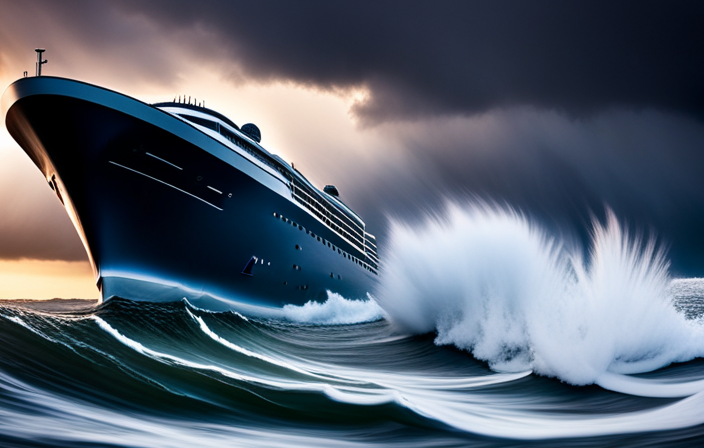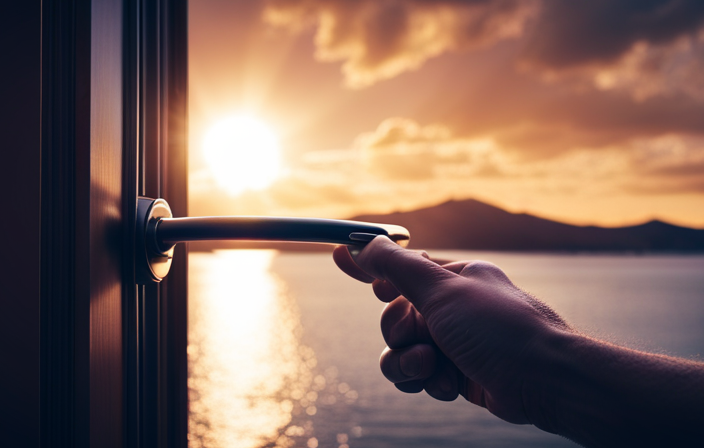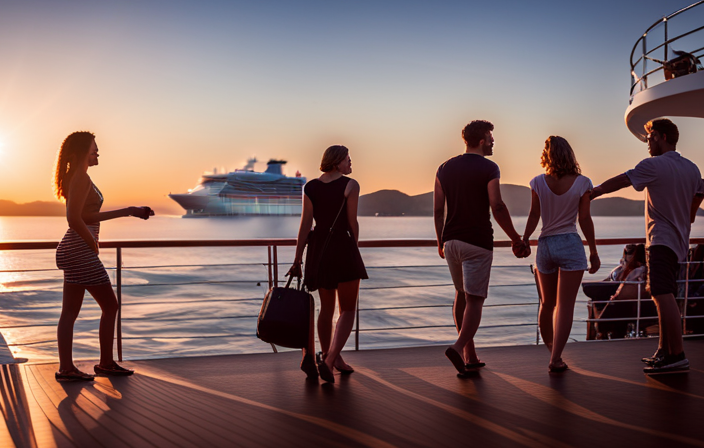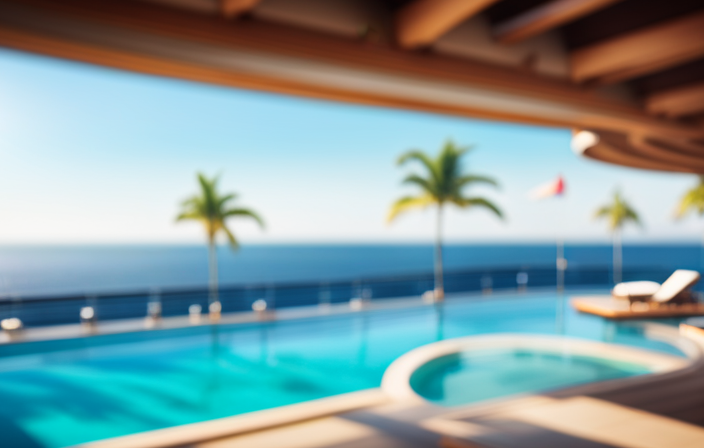Imagine yourself on the expansive deck of a large cruise ship, looking out over the boundless ocean. Everything is illuminated in the sunlight’s glow, with the sea softly rippling, creating a sense of peace. However, what occurs when these calm waters transform into a tempestuous storm?
As someone who has experienced rough seas firsthand, I can tell you that it’s not for the faint of heart. In this article, we will delve into what is considered rough seas for a cruise ship and explore the factors that contribute to these challenging conditions.
From understanding how rough seas impact passengers to learning how cruise lines handle such situations, we will provide valuable insights and tips for dealing with these turbulent waters. Safety measures and emergency procedures will also be discussed, along with passenger rights and compensation in case things don’t go as planned.
So grab your life vest and join me as we navigate through the world of rough seas on a cruise ship.
Key Takeaways
- Rough seas for a cruise ship are characterized by waves reaching heights of over 20 feet, challenging conditions at sea, and the potential for disruptions and discomfort.
- Cruise lines have a duty of care towards passengers and must provide necessary accommodations, assistance, and support during rough seas to ensure passenger well-being and reflect their commitment to safety.
- Passengers have rights and entitlements in the event of cruise disruptions, including compensation for lost vacation time and inconveniences caused by rough seas. Seeking appropriate compensation helps alleviate frustrations and ensures fair resolution for unforeseen circumstances.
- To ensure the well-being of passengers during rough seas, cruise ships have meticulously designed evacuation plans, emergency communication plans, trained personnel, and effective response strategies in place. These measures help maintain passenger safety, provide reassurance, and ensure order and efficiency during challenging conditions.
Understanding the Factors that Contribute to Rough Seas
There are several causes that can lead to rough seas on a cruise ship. Weather patterns, such as storms or high winds, can create turbulent conditions at sea. Sea currents, especially if they are strong or unpredictable, can also impact the stability of a cruise ship. The size and design of the ship can play a role in how it handles rough seas. Larger ships with stabilizers are generally more stable than smaller ones.
The effects of rough seas on passengers can vary. Some may experience discomfort and motion sickness, while others may suffer more serious injuries in extreme cases. These impacts can significantly affect the overall cruise experience for passengers.
Impact of Rough Seas on Passengers
When cruise ships encounter rough seas, it can have a significant impact on the comfort of passengers. The constant movement of the ship can lead to motion sickness, which is characterized by symptoms like nausea, dizziness, and vomiting. This can be especially challenging for individuals who are prone to motion sickness or those who are not accustomed to being at sea. Cruise lines understand the importance of passenger well-being and have implemented various measures to mitigate the effects of rough seas.
From stabilizing technologies to offering medication for motion sickness, they strive to ensure that passengers have a comfortable and enjoyable experience even in challenging conditions. Transitioning into how cruise lines handle rough seas, let’s explore their strategies for maintaining stability and safety onboard.
How Cruise Lines Handle Rough Seas
Ahoy there, matey! When the mighty ocean swells start tossing and turning, cruise lines skillfully navigate through the tempestuous waters to ensure a safe and steady voyage for all onboard. Cruise line protocols are in place to handle rough seas effectively. They closely monitor weather conditions and adjust the ship’s course accordingly to avoid areas of severe turbulence. Additionally, modern cruise ships are equipped with stabilizers that help reduce the impact of rough seas on passengers by minimizing excessive rolling and pitching motions.
Passenger experiences during rough seas can vary, but cruise lines prioritize their safety and comfort. Crew members are trained to provide assistance and reassurance during these challenging times. Onboard amenities such as handrails, non-slip surfaces, and grab bars are designed to enhance stability. In extreme cases, where the sea conditions become unbearable, cruise lines may alter itineraries or seek shelter in calmer waters.
Now that you understand how cruise lines handle rough seas, let’s explore some tips for dealing with these challenging conditions without compromising your enjoyment of the voyage
Tips for Dealing with Rough Seas
Batten down the hatches, because when the ocean gets feisty, these tips will help you navigate the challenges and keep your voyage smooth sailing.
Cruise ship motion can be intense during rough seas, causing discomfort and even seasickness for some passengers. To alleviate these symptoms, there are several relief options available.
First, consider choosing a cabin located in the middle of the ship as it experiences less movement. Additionally, focusing on a fixed point in the distance can help reduce feelings of dizziness. It’s also recommended to stay hydrated and avoid heavy meals that could worsen motion sickness.
If needed, over-the-counter medications like ginger or acupressure wristbands can provide relief.
As we’ll discuss next, being aware of safety measures and emergency procedures is crucial for any cruise ship journey.
Safety Measures and Emergency Procedures
When it comes to safety measures and emergency procedures on board a cruise ship, there are three key points that must be addressed:
-
Lifeboat drills and safety briefings: These are essential for all passengers to understand the proper procedures in case of an emergency at sea.
-
Crew training and response protocols: Crew members undergo rigorous training to ensure they can respond effectively in any situation, following strict protocols.
-
Emergency communication and evacuation plans: The ship is equipped with advanced communication systems and evacuation plans in place to ensure swift action can be taken if needed.
Lifeboat drills and safety briefings
Lifeboat drills and safety briefings are essential for passengers to familiarize themselves with emergency procedures. But have you ever wondered how these preparations change during rough seas? In such conditions, it becomes even more crucial for everyone on board to be well-versed in the use of lifeboat equipment and safety protocols.
To help you visualize the importance of these drills, imagine the following scenarios during rough seas:
- The ship rocking violently from side to side.
- Waves crashing against the hull with tremendous force.
- Passengers struggling to maintain balance as they navigate slippery decks.
- Lifeboats being lowered into churning waters.
These images highlight the need for thorough safety training and preparedness to ensure passenger safety. Understanding how crew members are trained and how they respond in emergencies will be discussed in the next section.
Crew training and response protocols
Trained crew members swiftly maneuver through the tumultuous waves, ensuring the safety of all passengers on board. Crew training plays a vital role in preparing ship personnel to respond effectively to various emergency situations at sea. From fire drills to man overboard scenarios, crew members undergo rigorous training programs that equip them with the necessary skills and knowledge to handle any crisis that may arise. Response protocols are carefully established and constantly reviewed to ensure a prompt and coordinated response in case of an emergency. These protocols dictate specific actions that crew members must take during different scenarios, such as initiating evacuation procedures or providing medical assistance. Regular drills and exercises further reinforce these response protocols, allowing the crew to practice their roles and responsibilities in a controlled environment. This constant training and adherence to response protocols enable the crew to efficiently safeguard passengers’ lives even in challenging circumstances.
Incorporating advanced technology and communication systems, crew members are well-equipped for effective emergency communication and evacuation plans.
Emergency communication and evacuation plans
As I mentioned earlier, crew training and response protocols are crucial in ensuring the safety of passengers during rough seas.
In addition to that, emergency communication and evacuation plans play a vital role in managing any potential crisis at sea. Cruise ships are equipped with advanced communication systems that allow for real-time updates on weather conditions and potential emergencies. These systems enable the crew to quickly disseminate information to both passengers and other crew members, ensuring everyone is aware of the situation and can take appropriate action.
Evacuation plans are meticulously designed to ensure an orderly and efficient evacuation process in case it becomes necessary. Passenger safety is the utmost priority, and these plans include designated assembly stations, clearly marked escape routes, lifeboat drills, and trained personnel to assist passengers during an emergency.
By having comprehensive emergency communication and evacuation plans in place, cruise ships can effectively respond to any unforeseen circumstances that may arise during rough seas. This ensures the well-being of all onboard as we navigate through challenging situations.
Moving forward into our next topic about passenger rights and compensation…
Passenger Rights and Compensation
Don’t worry, you’re entitled to compensation if your cruise is disrupted due to rough seas – imagine the waves reaching heights of over 20 feet! Cruise ship reimbursement and compensation for cruise ship incidents are important passenger rights that ensure a fair resolution when unforeseen circumstances arise. Here are three key points to consider:
-
Reimbursement for lost vacation time: If your cruise is cut short or delayed due to rough seas, you have the right to be reimbursed for any missed days or activities.
-
Compensation for inconveniences: In addition to refunding lost vacation time, cruise lines may offer compensation for inconveniences caused by disruptions, such as itinerary changes or canceled ports of call.
-
Duty of care: Cruise lines have a duty of care towards their passengers and must provide necessary accommodations and assistance during disruptions caused by rough seas.
Remember, understanding your passenger rights and seeking appropriate compensation can help alleviate any frustrations caused by unexpected incidents on your cruise journey.
Frequently Asked Questions
What are some common symptoms experienced by passengers during rough seas?
During rough seas, passengers may experience symptoms like nausea, dizziness, and vomiting. To manage seasickness, common remedies include taking over-the-counter medications, wearing acupressure bands, staying hydrated, and focusing on the horizon to reduce motion sickness.
Are there any specific areas or routes known for consistently rough seas?
Specific areas known for consistently rough seas include the North Atlantic Ocean, particularly the area between Newfoundland and Ireland, and the Drake Passage in the Southern Ocean. These routes are notorious for their challenging weather conditions.
How do cruise lines determine whether to proceed with a scheduled cruise during rough seas?
When determining whether to proceed with a scheduled cruise during rough seas, cruise lines follow strict protocols. These protocols consider the impact on the itinerary and prioritize passenger safety above all else.
What measures do cruise ships take to prevent damage caused by rough seas?
Cruise ships employ various measures to prevent damage caused by rough seas. These include stabilizer systems, ballast tanks, and advanced navigational technology. These measures help maintain stability, minimize the impacts of waves, and ensure passenger safety.
Can passengers request a refund or compensation if their cruise is significantly affected by rough seas?
Passenger rights and compensation policies vary among cruise lines. In case of significant disruption due to rough seas, passengers can request a refund or compensation according to the specific terms and conditions set by the cruise line.
Conclusion
In conclusion, navigating rough seas on a cruise ship can be quite the adventure. Just like a skilled captain who steers through stormy waters, cruise lines have protocols in place to ensure your safety and comfort.
By understanding the factors that contribute to rough seas and following the tips provided, you can make the most of your voyage even when faced with challenging conditions.
So embrace the rolling waves and trust that you are in capable hands as you embark on your unforgettable journey at sea.
Claire, a creative soul with an unquenchable thirst for storytelling, is an integral part of the Voyager Info team. As a dedicated writer, she weaves captivating narratives that transport readers to enchanting cruise destinations and beyond.
Claire’s love affair with writing began at an early age when she discovered the magic of words and their ability to craft worlds and emotions. Her innate curiosity led her to explore various literary genres, but it was travel writing that truly captured her heart. Drawing inspiration from her own globetrotting adventures and encounters with diverse cultures, Claire embarked on a journey to become a travel writer par excellence.











